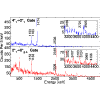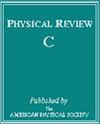B(E2) measurements in the yrast band of Mg28: Implications for the N=20 island of inversion
IF 3.4
2区 物理与天体物理
Q1 Physics and Astronomy
引用次数: 0
Abstract
High-precision lifetime measurements in were performed to study neutron shell evolution in Mg isotopes and the onset of the island of inversion. Using both the recoil distance and Doppler shift attenuation methods, five lifetimes were measured in addition to six upper limits. The observation of two long-lived, negative-parity states demonstrate the importance of studying Mg isotopes for the contribution of intruder configurations to -shell nuclei. Lifetimes of the and states of 1.81(5) ps and , respectively, demonstrate a loss of collectivity with increasing spin in the yrast band, permitting for distinguishing between current theoretical models. These measurements also highlight the progression of yrast structure across the Mg isotopic chain from rotational at to large shape mixing at and back to collective behavior at but with dominating intruder configurations.

Mg28 的 yrast 波段中的 B(E2)测量结果:对 N=20 反演岛的影响
对 Mg28 进行了高精度寿命测量,以研究镁同位素的中子壳演化和 N=20 反转岛的出现。利用反冲距离和多普勒频移衰减方法,测量了五个寿命和六个上限。对两种长寿命负奇偶态的观测表明,研究镁同位素对 sd 壳核的入侵者构型贡献具有重要意义。21+和41+态的寿命分别为1.81(5) ps和172(-10+11)stat.这些测量结果还凸显了整个镁同位素链上的 yrast 结构从 N=12 时的旋转到 N=16 时的大形状混合,再回到 N=20 时的集合行为,但其中入侵者构型占主导地位。
本文章由计算机程序翻译,如有差异,请以英文原文为准。
求助全文
约1分钟内获得全文
求助全文
来源期刊

Physical Review C
物理-物理:核物理
CiteScore
5.70
自引率
35.50%
发文量
0
审稿时长
1-2 weeks
期刊介绍:
Physical Review C (PRC) is a leading journal in theoretical and experimental nuclear physics, publishing more than two-thirds of the research literature in the field.
PRC covers experimental and theoretical results in all aspects of nuclear physics, including:
Nucleon-nucleon interaction, few-body systems
Nuclear structure
Nuclear reactions
Relativistic nuclear collisions
Hadronic physics and QCD
Electroweak interaction, symmetries
Nuclear astrophysics
 求助内容:
求助内容: 应助结果提醒方式:
应助结果提醒方式:


